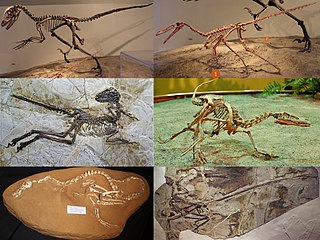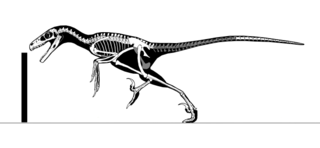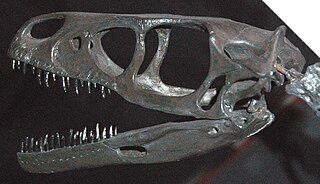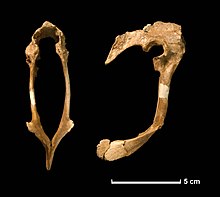
Velociraptor is a genus of small dromaeosaurid dinosaurs that lived in Asia during the Late Cretaceous epoch, about 75 million to 71 million years ago. Two species are currently recognized, although others have been assigned in the past. The type species is V. mongoliensis, named and described in 1924. Fossils of this species have been discovered in the Djadochta Formation, Mongolia. A second species, V. osmolskae, was named in 2008 for skull material from the Bayan Mandahu Formation, China.

Dromaeosauridae is a family of feathered coelurosaurian theropod dinosaurs. They were generally small to medium-sized feathered carnivores that flourished in the Cretaceous Period. The name Dromaeosauridae means 'running lizards', from Greek δρομαῖος (dromaîos), meaning 'running at full speed', 'swift', and σαῦρος (saûros), meaning 'lizard'. In informal usage, they are often called raptors, a term popularized by the film Jurassic Park; several genera include the term "raptor" directly in their name, and popular culture has come to emphasize their bird-like appearance and speculated bird-like behavior.

Sinornithosaurus is a genus of feathered dromaeosaurid dinosaur from the early Cretaceous Period of the Yixian Formation in what is now China. It was the fifth non–avian feathered dinosaur genus discovered by 1999. The original specimen was collected from the Sihetun locality of western Liaoning. It was found in the Jianshangou beds of the Yixian Formation, dated to 124.5 million years ago. Additional specimens have been found in the younger Dawangzhangzi bed, dating to around 122 million years ago.

Saurornitholestes is a genus of carnivorous dromaeosaurid theropod dinosaur from the late Cretaceous of Canada (Alberta) and the United States.

Atrociraptor is a genus of saurornitholestine dromaeosaurid theropod dinosaur from the Late Cretaceous of Alberta, Canada.

Bambiraptor is a Late Cretaceous, 72-million-year-old, bird-like dromaeosaurid theropod dinosaur described by scientists at the University of Kansas, Yale University, and the University of New Orleans.

Adasaurus is a genus of dromaeosaurid dinosaur that lived in Asia during the Late Cretaceous period about 70 million years ago. The genus is known from two partial specimens found in the Nemegt Formation of Mongolia that were partially described in 1983 by the paleontologist Rinchen Barsbold.

Achillobator is a genus of large dromaeosaurid theropod dinosaur that lived during the Late Cretaceous period about 96 million to 89 million years ago in what is now the Bayan Shireh Formation of Mongolia. The genus is currently monotypic, only including the type species A. giganticus. The first remains were found in 1989 during a Mongolian-Russian field expedition and later described in 1999. Remains at the type locality of Achillobator may represent additional specimens. It represents the first and largest dromaeosaurid known from the Bayan Shireh Formation.

Microraptoria is a clade of basal dromaeosaurid theropod dinosaurs. The first microraptorians appeared 125 million years ago in China. Many are known for long feathers on their legs and may have been semiarboreal powered fliers, some of which were even capable of launching from the ground. Most microraptorians were relatively small; adult specimens of Microraptor range between 77–90 centimetres long (2.53–2.95 ft) and weigh up to 1 kg (2.2 lb), making them some of the smallest known nonavialan dinosaurs.

Pyroraptor is an extinct genus of paravian dinosaur, probably a dromaeosaurid or unenlagiid, from the Late Cretaceous Ibero-Armorican island, of what is now southern France and northern Spain. It lived during the late Campanian and early Maastrichtian stages, approximately 70.6 million years ago. It is known from a single partial specimen that was found in Provence in 1992, after a forest fire. The animal was named Pyroraptor olympius by Allain and Taquet in 2000.

Zapsalis is a genus of dromaeosaurine theropod dinosaurs. It is a tooth taxon, often considered dubious because of the fragmentary nature of the fossils, which include teeth but no other remains.

Itemirus is a genus of dromaeosaurid theropod dinosaur from the Turonian age of the Late Cretaceous period of Uzbekistan.

Dromaeosaurinae is a subfamily of the theropod group Dromaeosauridae. The earliest dromaeosaurine is Utahraptor, dating back to the Early Cretaceous period in North America, however, some isolated teeth seems to represent an indeterminate species of dromaeosaurine, coming from the Late Jurassic period in Africa. If true, this will push their range to the Jurassic period, instead of the Cretaceous, as in most dromaeosaurs.

Velociraptorinae is a subfamily of the theropod group Dromaeosauridae. The earliest velociraptorines are probably Nuthetes from the United Kingdom, and possibly Deinonychus from North America. However, several indeterminate velociraptorines have also been discovered, dating to the Kimmeridgian stage, in the Late Jurassic Period. These fossils were discovered in the Langenberg quarry, Oker near Goslar, Germany.

Shanag is a genus of dromaeosaurid theropod dinosaur from the Early Cretaceous Period of Mongolia.

Saurornitholestinae is a subfamily of the theropod group Dromaeosauridae. The saurornitholestines currently include three monotypic genera: Atrociraptor marshalli, Bambiraptor feinbergi, and Saurornitholestes langstoni. All are medium-sized dromaeosaurs from the Late Cretaceous of western North America. The group was originally recognized by Longrich and Currie as the sister taxon to a clade formed by the Dromaeosaurinae and Velociraptorinae. However, not all phylogenetic analyses recover this group and/or with the same proposed genera.

Eudromaeosauria is a subgroup of terrestrial dromaeosaurid theropod dinosaurs. They were small to large-sized, feathered hypercarnivores that flourished in the Cretaceous Period.

Acheroraptor is an extinct genus of dromaeosaurid theropod dinosaur known from the latest Maastrichtian Hell Creek Formation of Montana, United States. It contains a single species, Acheroraptor temertyorum. A. temertyorum is one of the two geologically youngest known species of dromaeosaurids, the other being Dakotaraptor, which is also known from Hell Creek. A basal cousin of Velociraptor, Acheroraptor is known from upper and lower jaw material.

This timeline of dromaeosaurid research is a chronological listing of events in the history of paleontology focused on the dromaeosaurids, a group of sickle-clawed, bird-like theropod dinosaurs including animals like Velociraptor. Since the Native Americans of Montana used the sediments of the Cloverly Formation to produce pigments, they may have encountered remains of the dromaeosaurid Deinonychus hundreds of years before these fossils came to the attention of formally trained scientists.

Dakotaraptor is a potentially chimaeric genus of maniraptoriform theropod dinosaur that lived in western North America during the Late Cretaceous period. The remains have been found in the Maastrichtian-aged Hell Creek Formation, dated to the very end of the Mesozoic era, making Dakotaraptor potentially one of the last surviving dromaeosaurids, though other researchers have disputed its classification. The remains of D. steini were discovered in a multi-species bonebed. Elements of the holotype and referred specimens were later found to belong to trionychid turtles, and it is unclear whether further analysis of potential non-dromaeosaurid affinities of the holotype and referred material can be properly conducted, because currently the type specimen is housed in private collection. Phylogenetic analyses of D. steini place it in a variety of positions within Dromaeosauridae.

























